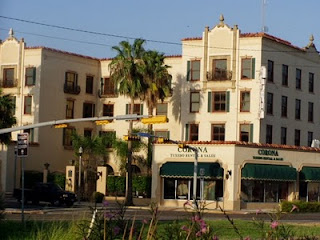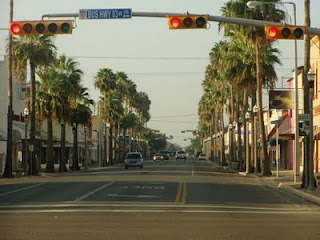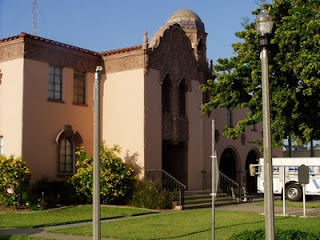Discrimination and segregation:
(Clarification: Up until the late 1800s the Rio Grande was a feature of the terrain, not a border. Here in South Texas the general population is 95% Hispanic/ Mexican American. Depending on how and when one was raised, the lable of Hispanic, Mexican American, or Mexican was adopted. On the other side of the equation are the Whites, Anglos, or Gringos. The commonly used term is Anglo. My preferred terminology is Mexican American and Anglo.)
Segregated schools:
I went to the Weslaco Museum to check out its new location and exhibits. I was impressed with the museum's content and display. The main exhibit focused on education in Weslaco. It mentioned how the schools were laid out. When the first high school was built and where students went to high school before the new Weslaco had a high school. In black and white, I read that the town's first schools were established to segregate the Mexican American students from the non-Hispanic, Anglos. I have checked with friends and classmates and they seem to have always known this.
Living here, the norm was what it was, and I did know any better. I doubt that the Anglo students considered it discrimination or segregation either. The town is divided by the railroad tracks, north side and south side. Back in the day, the South side had the Woolworth, J.C.Penney, the fancy schmancy Wells of Welaco (clothing), Mattar Store for Men, etc. The North side had an assortment of taverns and bars, restaurants, the cotton gin, and other packing sheds. Needless to say, the North side was known as the Mexican side.
The neighborhoods on the South side were primarily brick facades, ranch style or two story houses. The owners were almost 100% white, Middle and upper-middle class folks. Very few Mexican Americans lived in the South side of Weslaco. I don't think there was a ban on Hispanics living there. On the North side, the houses were primarily wood framed on smaller lots. The residents were primarily Mexican American.
Primarily there were two elementary schools, Horton School (North side/Hispanic) and Stephen F. Austin School (South side - Anglo). The buses would come from the rural areas to the north with the kids. They would stop at Horton and drop off the Hispanic kids, then proceed to Stephen F. Austin to drop off the Anglo kids. The same dynamic from the rural South, stopping first at Stephen F. and then at Horton.
Maybe the reason why I was not aware was that I attended Catholic school, St. Joan of Arc, until the end of the 5th grade. Maybe I was 11 or 12 then, and clueless about many things. The Catholic school had a mixed population. I always thought it odd that there were Anglos who were Catholic. My life at St. Joan will have a separate entry in the future. This segregation would continue until the federal courts mandated busing integration. When I left the parochial school, another elementary, for 5th and 6th, Sam Houston Elementary, had opened and there I went.
Reunion of the segregated
The meeting place for these two separate groups of students was high school. Working on the 10th reunion, I learned that many Mexican students considered the reunions something for the Anglo students. As a result, fewer Mexican American students than Anglo students attended reunions. When I went door to door asking classmates to sign up for the reunion, a common respond was, "Nah! That's only for Gringos."
At the last high school class reunion the word "segregation" was uttered. As the students gathered and began to share their stories, we all separated into our "clicks." The jocks, the band members, and the geeks found each other. At some point in the evening, all of the Mexican students, maybe 15, were sitting together. We were sharing as members of a special "click." One of the Anglo students commented, "Why are you all segregating yourselves?" This student had not considered that an outsider could have observed that she and her Anglo classmates were also segregated into a larger group.
After the reunion and after thinking about the "segregation" comment, I realized the following. This high school class had three groups of students. The Anglo kids had known each other since 1st grade, for the most part. These classmates were very close. There were a few students who moved into the school district later. For the most part, the Anglo kids had started at Stephen F. and continued through high school.
The Mexican American students came from either the North side elementary school or the Catholic school. Since I left the Catholic school after the 5th grade, I had friends from both Catholic and public schools. The Catholic school had grades 1-8. Those that stayed for their entire sentence, graduated and went to Weslaco High School. Most of the ones that I know that graduated, did it because their parents forced them. My siblings and I left the Catholic school because my parents could not afford it.
So here is my high school class, Anglos from Stephen F., Mexican Americans from Horton and Sam Houston, and the mix of Anglo and Mexican from St. Joan. Although we were now together there were still things that separated us. One of those things was tacos.
The Stigma of eating tacos
The sociologists' view of "discrimination" is to deny any privilege or right to an individual or a group, based on one attribute, such as heritage, language, religion, etc. I don't remember a time when I felt discriminated against. Although there certainly was discrimination. The Blacks who worked on the railroad, back in the day, were not allowed to eat in the main dining room of the Keno Cafe. These men ate in the kitchen. My grandparents considered the Anglo as the "boss man." They would not dare do some things because they did not consider themselves as equals to the Anglo. This was a learned behavior and maybe I learned through observation of them and others. I am referring to eating tacos.
Unlike today, where tacos are almost a food group unto themselves, in the past, tacos were in the Mexican and mexican American domain. Tacos were something we brought for lunch to school or work. I don't know why we did not bring PBand J sandwiches or balony sandwiches. I did eat balony tacos, though.
Along with others, when I took tacos for lunch, I would not take the taco out of the brown bag. I would unwrap it in the bag and allow a small portion to surface, take a bite and move the taco forward. What was this about? No one told me not to eat tacos. What then caused me and others to hide the tacos we took to school for lunch? I think this is one of those learned behaviors. I can assume it was embarrassment. It seems odd in 2010 to feel bad about eating a taco, since it is a mainstream food. Driving through Wyoming, one morning, I stopped for gas and coffee. The place had a deli selling a variety of taco fillings. There were 5 Wyominans (?) in line and they all ordered at least one taco for breakfast. Consider that this is Wyoming and Wyoming is not in the middle of nowhere, IT IS. (My apologies to the Wyomians reading this.)
Privilege and luck
Since I have been back, I have met with high school classmates that I did not know well in high school. These guys were not in my circles, in or out of school. I found out that I was indeed privileged. One of these students would work in the fields before and after school. He was not allowed to do football, band or any other activity. On graduation night he did not attend the all-night party. His father left him some gas money so that he could follow the family to Wisconsin to work the fields. After his stint in the military, he thought he would go to college using the GI Bill. That dream was short-lived when his father found out his plans.
The story of two other former classmates was similar. They had to work to help the family. All that they earned was not theirs to keep. On the other hand, I had a choice. My father's mantra was, "You are either in school or working." We could drop out of school at any time, but we would have to work. We could have part-time jobs and keep the money earned. We cold participate in extra-curricular activities so long as the grades did not suffer. This was a privilege that I did not know I had. I was unaware of how touch some of my classmates had it.
Luck played a role in my school life. As a junior in high school, I went to chemistry class to find that there were only three students scheduled. Somebody messed up the schdule. As a result of the rescheduling, I was in classes where I was the only Mexican American kid. This was another bit of segregation that happened back in the day. Not so good students went this way and the better students went that way - college bound and vocational.
Although at first I did not like that Mrs Wallace, English, always called on me first, I got to the point of being well prepared for that challenge. My classmates in English class included those that would be the Valedictorian, Saluditorian, and the top 10 per cent of the graduating class. I became friends with these students who were bonded together since 1st grade at Stephen F. Austin school.
From them I learned about going to college and taking the SAT and ACT exams. I do not remember ever meeting with a high school counselor to talk about college or scholarships. What would my life be if I had not been so lucky as to have my class schedule messed up in the 11th grade.
I am happy to report that I am still questioning and still learning. There are a number of high school and St. Joan classmates that I have not seen. I am anxious to discover what I will learn from them. I hope to have some picture to accompany this post soon.
Joe V









































